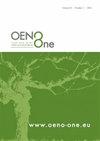An operational model for capturing grape ripening dynamics to support harvest decisions
IF 2.2
3区 农林科学
Q3 FOOD SCIENCE & TECHNOLOGY
引用次数: 1
Abstract
Grape ripening is a critical phenological phase during which many metabolites that impact wine quality accumulate in the berries. Major changes in berry composition include a rapid increase in sugar and a decrease in malic acid content and concentration. Its duration is highly variable depending on grapevine variety, climatic parameters, soil type and management practices. Together with the timing of mid-veraison, this duration determines when grapes can be harvested.Viticulturists and winemakers monitor the sugar-to-total acidity ratio (S/TA) during grape ripening and start harvesting grapes when this ratio reaches the optimum value for the desired wine style. The S/TA ratio evolves linearly as a function of thermal summation during the first four weeks following the onset of ripening. The linearity of the evolution of the S/TA ratio as a function of thermal time during the first four weeks following mid-veraison is applied in this study on two large data sets encompassing (1) 53 varieties studied during 10 years with two to four replicates for each combination of year and cultivar and (2) two varieties, cultivated on three soil types over 13 years. Grape ripening speed is highly variable. The effects of the year impact ripening speed more than the effects of the soil or the variety, although all three effects are highly significant. Grape ripening speed decreases with berry weight and also varies with vine water status. By using this approach, viticulturists and winemakers can assess four weeks after mid-veraison, for each individual vineyard parcel, at what speed grape ripening progresses. Combined with precise mid-veraison scoring, expertise from previous vintages and complementary approaches like sensory assessment of berries, it allows harvest date estimates to be fine-tuned. The results of this study can also be used to identify slow ripening varies, which are better performing in warm climates and, thus, better adapted to climate change.捕获葡萄成熟动态以支持收获决策的操作模型
葡萄成熟是一个关键的酚期,在此期间,许多影响葡萄酒质量的代谢产物在浆果中积累。浆果成分的主要变化包括糖的快速增加以及苹果酸含量和浓度的降低。其持续时间因葡萄品种、气候参数、土壤类型和管理实践而异。再加上葡萄成熟中期的时间,这个持续时间决定了葡萄何时可以收获。葡萄种植者和酿酒师在葡萄成熟过程中监测糖与总酸度的比值(S/TA),并在该比值达到所需葡萄酒风格的最佳值时开始收获葡萄。在成熟开始后的前四周内,S/TA比率作为热总和的函数线性演变。在这项研究中,S/TA比率作为中期后前四周热时间函数的线性演变应用于两个大数据集,包括(1)在10年内研究的53个品种,年份和品种的每个组合有两到四个重复;(2)在三种土壤类型上培养13年的两个品种。葡萄成熟速度变化很大。年份的影响比土壤或品种的影响更能影响成熟速度,尽管这三种影响都非常显著。葡萄成熟速度随浆果重量的增加而降低,也随葡萄水分状况的变化而变化。通过使用这种方法,葡萄种植者和酿酒师可以评估葡萄成熟中期后四周,每个葡萄园地块的葡萄成熟速度。结合精确的中白葡萄酒评分、以前年份的专业知识以及浆果感官评估等互补方法,它可以对收获日期的估计进行微调。这项研究的结果也可以用来识别慢熟品种,这些品种在温暖的气候中表现更好,从而更好地适应气候变化。
本文章由计算机程序翻译,如有差异,请以英文原文为准。
求助全文
约1分钟内获得全文
求助全文
来源期刊

OENO One
Agricultural and Biological Sciences-Food Science
CiteScore
4.40
自引率
13.80%
发文量
85
审稿时长
13 weeks
期刊介绍:
OENO One is a peer-reviewed journal that publishes original research, reviews, mini-reviews, short communications, perspectives and spotlights in the areas of viticulture, grapevine physiology, genomics and genetics, oenology, winemaking technology and processes, wine chemistry and quality, analytical chemistry, microbiology, sensory and consumer sciences, safety and health. OENO One belongs to the International Viticulture and Enology Society - IVES, an academic association dedicated to viticulture and enology.
 求助内容:
求助内容: 应助结果提醒方式:
应助结果提醒方式:


